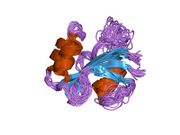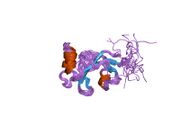Biology:Peptidyl-prolyl cis-trans isomerase NIMA-interacting 4
From HandWiki
Short description: Protein-coding gene in the species Homo sapiens
 Generic protein structure example |
Peptidyl-prolyl cis-trans isomerase NIMA-interacting 4 is an enzyme that in humans is encoded by the PIN4 gene.[1][2][3]
References
- ↑ "Characterization of novel elongated Parvulin isoforms that are ubiquitously expressed in human tissues and originate from alternative transcription initiation". BMC Mol Biol 7: 9. Mar 2006. doi:10.1186/1471-2199-7-9. PMID 16522211.
- ↑ "The DNA binding parvulin Par17 is targeted to the mitochondrial matrix by a recently evolved prepeptide uniquely present in Hominidae". BMC Biol 5: 37. Oct 2007. doi:10.1186/1741-7007-5-37. PMID 17875217.
- ↑ "Entrez Gene: PIN4 protein (peptidylprolyl cis/trans isomerase) NIMA-interacting, 4 (parvulin)". https://www.ncbi.nlm.nih.gov/sites/entrez?Db=gene&Cmd=ShowDetailView&TermToSearch=5303.
Further reading
- "Identification and characterization of a 14 kDa human protein as a novel parvulin-like peptidyl prolyl cis/trans isomerase.". FEBS Lett. 446 (2–3): 278–82. 1999. doi:10.1016/S0014-5793(99)00239-2. PMID 10100858.
- "Identification of eukaryotic parvulin homologues: a new subfamily of peptidylprolyl cis-trans isomerases". Biochem. Biophys. Res. Commun. 259 (3): 557–62. 1999. doi:10.1006/bbrc.1999.0828. PMID 10364457.
- "NMR solution structure of hPar14 reveals similarity to the peptidyl prolyl cis/trans isomerase domain of the mitotic regulator hPin1 but indicates a different functionality of the protein". J. Mol. Biol. 301 (4): 1003–17. 2000. doi:10.1006/jmbi.2000.4013. PMID 10966801.
- "Solution structure of the human parvulin-like peptidyl prolyl cis/trans isomerase, hPar14". J. Mol. Biol. 305 (4): 917–26. 2001. doi:10.1006/jmbi.2000.4293. PMID 11162102.
- "Identification and characterization of the potential promoter regions of 1031 kinds of human genes". Genome Res. 11 (5): 677–84. 2001. doi:10.1101/gr.gr-1640r. PMID 11337467.
- "Isolation and proteomic characterization of human Parvulin-associating preribosomal ribonucleoprotein complexes". J. Biol. Chem. 277 (26): 23773–80. 2002. doi:10.1074/jbc.M201181200. PMID 11960984.
- "The N-terminal basic domain of human parvulin hPar14 is responsible for the entry to the nucleus and high-affinity DNA-binding". J. Mol. Biol. 321 (2): 235–47. 2002. doi:10.1016/S0022-2836(02)00615-0. PMID 12144781.
- "Generation and initial analysis of more than 15,000 full-length human and mouse cDNA sequences". Proc. Natl. Acad. Sci. U.S.A. 99 (26): 16899–903. 2003. doi:10.1073/pnas.242603899. PMID 12477932. Bibcode: 2002PNAS...9916899M.
- "Phosphorylation of the N-terminal domain regulates subcellular localization and DNA binding properties of the peptidyl-prolyl cis/trans isomerase hPar14". J. Mol. Biol. 330 (5): 955–66. 2003. doi:10.1016/S0022-2836(03)00713-7. PMID 12860119.
- "The status, quality, and expansion of the NIH full-length cDNA project: the Mammalian Gene Collection (MGC)". Genome Res. 14 (10B): 2121–7. 2004. doi:10.1101/gr.2596504. PMID 15489334.



